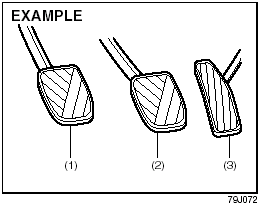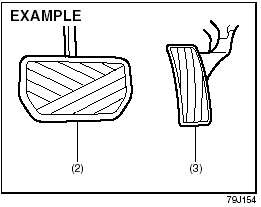Pedals

Manual transaxle

Automatic transaxle
Clutch Pedal (1)
(For manual transaxle).
The clutch pedal is used to disengage the drive to the wheels when starting the engine, stopping or shifting the gearshift lever. Depressing the pedal disengages the clutch.
CAUTION:
Do not drive with your foot resting on
the clutch pedal. It could result in
excessive clutch wear or clutch damage.
Brake Pedal (2)
Your SUZUKI vehicle is equipped with either front and rear disc brakes or front disc brakes and rear drum brakes.
Depressing the brake pedal applies both sets of brakes.
You may hear occasional brake squeal when you apply the brakes. This is a normal condition caused by environmental factors such as cold, wet, snow, etc.

WARNING:
If brake squeal is excessive and
occurs each time the brakes are
applied, you should have the brakes
checked by your SUZUKI dealer.

WARNING:
Do not “ride” the brakes by applying
them continuously or resting your
foot on the pedal. This will result in
overheating of the brakes which
could cause unpredictable braking
action, longer stopping distances or
permanent brake damage.
Accelerator Pedal (3)
This pedal controls the speed of the engine. Depressing the accelerator pedal increases power output and speed.
See also:
Winning Styling
The Kizashi actually turns heads, and that's rare in the midsize sedan class.
After more than a year, I like it even more; with the new Sport treatment, the
car looks a bit more aggressive without ...
Air Conditioning System
If you do not use the air conditioner for a
long period, such as during winter, it may
not give the best performance when you
start using it again. To help maintain optimum
performance and durabil ...
Corrosion Prevention
It is important to take good care of your
vehicle to protect it from corrosion.
Listed below are instructions for how to
maintain your vehicle to prevent corrosion.
Please read and follow these in ...
